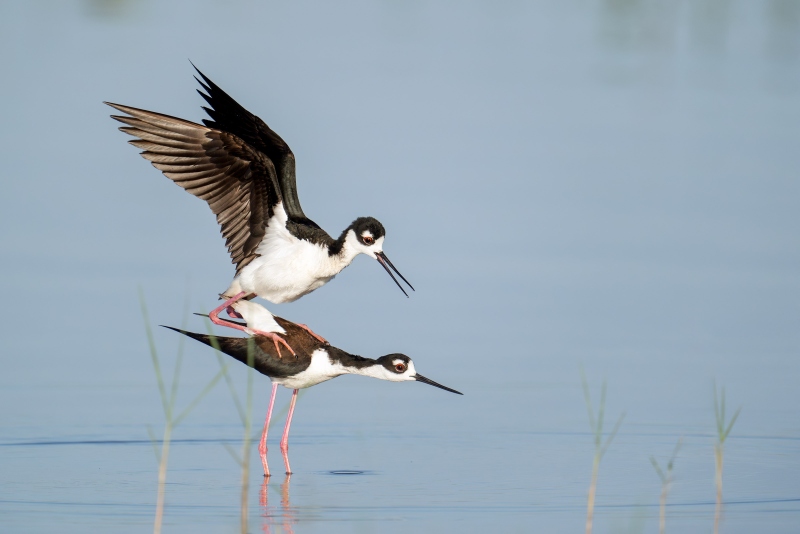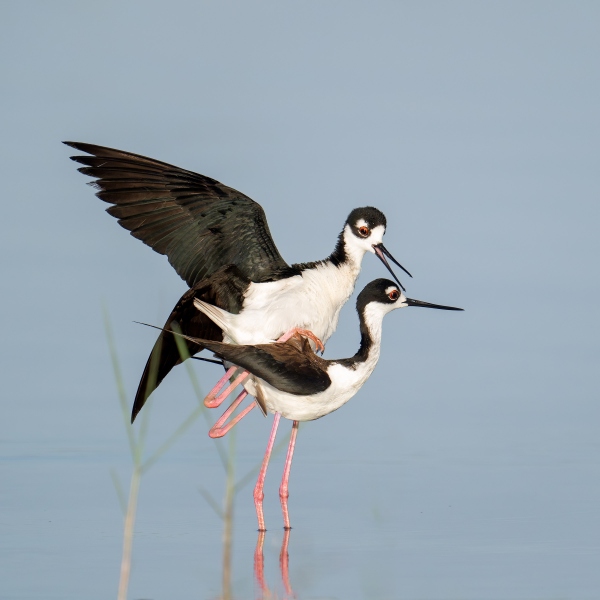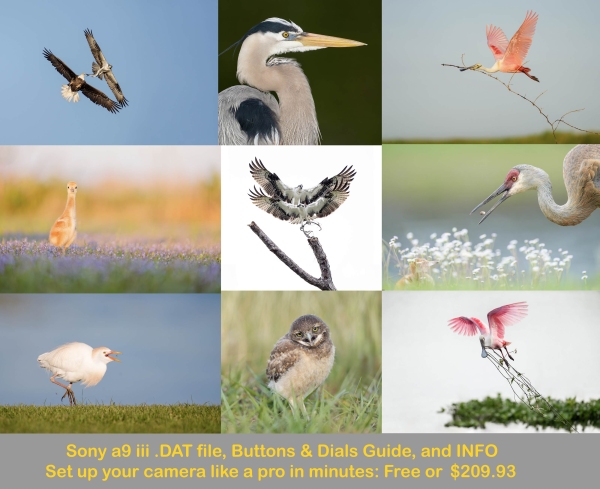Your Call?
Which of today’s two featured images do you like best? Why? Should I have replaced the head of the female? Why or why not?
Important Notice
After an update on 4 May, WordPress stopped sending post notifications. We are aware of the issue and are working on rectifying it. You can always visit the blog by visiting or bookmarking www.BIRDSASART-Blog.com.
Supporting My Efforts Here
If you enjoy and learn from the blog, please consider using one of my affiliate links when purchasing new gear. It will never cost you a single penny. To support my effort here, please order from B&H by beginning your search here. Or, click here, to order from Bedfords and enter the discount code BIRDSASART at checkout to receive 3% cash back to your credit card and enjoy free Second-Day Air Fed-Ex shipping. It is always best to write for advice via e-mail.
In many cases, I can help you save some serious dollars. And/or prevent you from purchasing the wrong gear.
One Reason that the Sony a9 iii is Best for Me
Lots of folks feel that 120 fps is overkill for bird photography. I do not. With so many frames to choose from, folks need to learn to distinguish among very similar photos, often many dozens of them. As always, the very best images jump out, but only if you know what to look for. I recently sold two of my a1 bodies and purchased a second a9 iii. Perhaps the world’s best flight photographer, Arash Hazeghi, believes that the Sony a1 is best for him. Could we both be right? More on that soon here on the BAA blog.
|
|
|
This image was created on 4 June 2024 down by the lake near my home at Indian Lake Estates, FL. Standing at full height — learn why in the video, I used the Robus RC-5558 Vantage Series 3 Carbon Fiber Tripod/Levered-Clamp FlexShooter Pro-mounted Sony FE 600mm f/4 GM OSS lens, the Sony FE 2.0x Teleconverter, and the ridiculously amazing Sony a9 III Mirrorless Camera. The exposure was determined via Zebra technology with ISO on the Thumb Dial. ISO 2000. 1/4000 sec. at f/8 (wide open) in Manual mode. When evaluated in RawDigger, the raw file exposure was determined to be perfect. AWB at 7:43:24am on a sunny morning. Zone/AF-C with Bird Face-eye AF enabled performed perfectly even at 1200mm. Be sure to click on the image to enjoy a high-res version. Image #1: Black-necked Stilts — pre-copulatory stand |
The Pre-copulatory Stand
During the pre-copulatory stand, the male jumps atop the female and practices maintaining his balance. It can be tough on windy days. This behavior is commonly seen in other bird families, especially the gulls and terns. I have seen male Royal Terns stand atop the females for several minutes at a time without ever copulating. Anita North has an image of a Royal Tern triple header — it is hard to figure out what is going on there. I will try to get that image from her and share it here with you.
After most BNST and American Avocet copulations there is usually a short dance and a wing over ceremony, but this guy simply flew away to the north.
|
|
|
This image was also created on 4 June 2024 down by the lake near my home at Indian Lake Estates, FL. Standing at full height –learn why in the video, I used the Robus RC-5558 Vantage Series 3 Carbon Fiber Tripod/Levered-Clamp FlexShooter Pro-mounted Sony FE 600mm f/4 GM OSS lens, the Sony FE 2.0x Teleconverter, and the ridiculously amazing Sony a9 III Mirrorless Camera. The exposure was determined via Zebra technology with ISO on the Thumb Dial. ISO 2000. 1/4000 sec. at f/8 (wide open) in Manual mode. When evaluated in RawDigger, the raw file exposure was determined to be perfect. AWB at 7:43:27am on a sunny morning. Zone/AF-C with Bird Face-eye AF enabled performed perfectly even at 1200mm. Be sure to click on the image to enjoy a high-res version. Image #2: Black-necked Stilts copulating — the cloacal kiss |
Three Seconds Later
Images that show the cloacal kiss are rare because the action takes only a second.
Image Optimization Question
Should I have replaced the head of the female? Why or why not?
|
|
a9 iii E-mail Set-up and Info Guide |
a9 iii E-mail Set-up and Info Guide
For those who think that my comments on the a9 iii are pure hype, know that I sold the second of my three a1 bodies last week. And on June 5th, I purchased a second a9 iii body! Lots more on the switch coming soon.
If you plan on purchasing a Sony a9 III Mirrorless Camera (or anything else for that matter), please remember to use or write for either my Bedfords discount code or my B&H affiliate link. Folks who use one of my two affiliate links to purchase the a9 III will receive my .DAT settings (the complete camera set-up), a Buttons and Dials Guide, and my a9 iii INFO Sheet, all for free.
Typos
With all blog posts, feel free to e-mail or to leave a comment regarding any typos or errors.

















I like Image 2 better. First, it’s the real deal, copulation, not pre-copulation. Second, it answers the age old question of where those long legs go during copulation. Third, while I’m not as committed to perfect head angles as Artie, here I think her modest look to the left works–it seems more real, more in the moment, more responsive to her mate than to the camera. She’s in her world, not ours.
Thanks for explaining to me why I like Image #2 best. Looks as if she is looking away from him also. The male’s wings down as compared to Image #1 led me to a square crop to put more emphasis on the birds.
a
Artie
I still love my ridiculously amazing Sony A1 that aside i am loving image #1 both pair have great head angles and the image has more room about it and to me very pleasing with the 3 grasses in front of the couple soft pleasing bg and great color.
Image #2 just doesn’t have that wow factor and she seems to be looking to her left and that is not a deal breaker by no means and no head replacement as it is gooder as shot imho i just think the stronger image is #1
Always with love b
Hey Bob, What ever you do, do not try an a9 iii.
with love, artie
And don’t fall off the cliff 🙂
Always with love b
Even more important, “Don’t fall off a cliff when trying out an a9 iii.”
a
I like the first image better. Not a big fan of square crops and the female’s head is turned away in the second image. I watched your video and several times you mentioned you could’ve made 840 images in 7 seconds. But according to some so called “Internet experts”, the camera is limited to 1.6 seconds of continuous shooting which amounts to 196 uncompressed 14-bit raw images. And then there is the time to clear the buffer. So what’s your experience in real-world usage?
Hey Moe,
Square crops are sometimes best 🙂 Unless you are not open to them.
#1: I am shooting full sized compressed RAW; I think that they are half the size. As you know, I am a technical dummy. After 1-2 seconds, the camera does begin to stutter as the buffer clears. But even when creating the stilt sequence, I never had to stop shooting. If I liked doing tests, I could check that out. But I am not disciplined enough to do tests 🙂
See you on Long Island.
with love, artie
Moe, If the female were looking straight ahead in Image #2, which would be the better image?
a
Hi, Artie. Even if the female was looking straight ahead, I think I would still prefer the first image. I like the wing position better in the first image. I also like that the male looks more “stable” in image #1 as opposed to looking like he is falling off or trying to gain balance in image #2. maybe, that’s part of the appeal in #2.
I’m not against square crops and I’ll do so when needed. But in general, if an image works in both square and horizontal/vertical positions, I opt for the latter.
Pre-copulatory stands can be dangerous 🙂
See Cliff’s comments above along with my Reply.
a